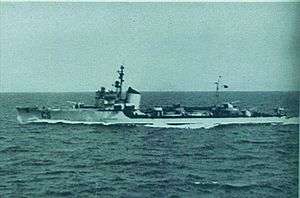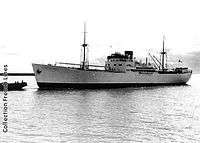Battle of the Cigno Convoy
| Battle of the Cigno Convoy | |||||||
|---|---|---|---|---|---|---|---|
| Part of the Battle of the Mediterranean of World War II | |||||||
 Italian torpedo boat Cassiopea | |||||||
| |||||||
| Belligerents | |||||||
|
|
| ||||||
| Commanders and leaders | |||||||
|
Cdr. Basil Jones[2] Lt.Cdr. Lawrence St. George[3] |
Captain Carlo Maccaferri Captain Vittorio Nasta[4] | ||||||
| Strength | |||||||
| 2 destroyers |
2 torpedo boats 1 transport ship | ||||||
| Casualties and losses | |||||||
|
1 destroyer scuttled 1 destroyer damaged 10 dead |
1 torpedo boat sunk 1 torpedo boat disabled 100–120 dead | ||||||
The Battle of the Cigno Convoy was a naval engagement between two British Royal Navy destroyers and two Italian Regia Marina torpedo boats which took place southeast of Marettimo island, on the early hours of 16 April 1943. The Italian units were escorting the transport ship Belluno, of 4,200 long tons (4,300 t). The British force was fought off by the Italian units, at the cost of one torpedo boat. One of the British destroyers, disabled by Italian gunfire, had to be scuttled after the action.
Background
The battle was part of the daily aerial, naval and submarine campaign mounted by the Allies against Axis forces, in the spring of 1943, in order to achieve a complete naval and air supremacy around North Africa and Sicily. Their aim was to isolate and defeat the bulk of the German Afrika Corps and the Regio Esercito (Italian Royal Army) in Tunis by strangling their supply lines. The struggle was so fiercely contested that the maritime area between Italy and Africa was dubbed the "route of death".[5]
By April, Axis merchant ship losses reached an average of 3.3 per day.[6] The huge extension of minefields planted by both sides made surface trips against Axis shipping more unlikely than during the Libyan campaign.[7] The supply route for the Regia Marina (Italian Royal Navy) was also shorter but the Allied air supremacy and the attrition of the war made it almost impossible to assemble large convoys. This along with a shortage of fuel, forced the Italians to use small and fast destroyers or torpedo boats to escort their cargo ships heading to Africa.[8] The convoys were only capable of making 8–10 kn (9.2–11.5 mph; 15–19 km/h) in practice, due to the loss of the main high-speed cargo ships by 1943.[9]
The action

One of these small convoys – comprising two Italian Spica-class torpedo boat Cigno and Cassiopea escorting the 4,200 long tons (4,300 t) transport Belluno – sailed from Trapani bound for Tunis on 15 April. A rearguard escorting force composed of the Ciclone-class torpedo boat Tifone and the Spica-class Climene was scheduled to depart a couple of hours later from Palermo to reinforce the convoy.[10] Additionally, Tifone had the secondary mission of delivering aviation fuel to Bizerte. The fuel was pumped right into her fore holds.[11]
At 02:38 on the 16th, the forward escort spotted two British destroyers approaching – Pakenham and Paladin. This was one of the few night engagements in the Mediterranean in which the British failed to take their opponents by surprise, owing to the full moon.[1][12] At 2:42 Pakenham's radar picked up the Italian flotilla at a range of 7,200 yards.[13] Aware of the incoming battle, Cigno made light signals to Tifone, whose commander ordered the convoy to reverse course. Belluno turned back to the northeast under the protection of the rear escorting force.[14]
The exchange of fire began at 2:48. The first ship to be hit was Cigno, which was badly damaged but continued firing until sunk at 03:00 by a torpedo launched by Paladin, with the loss of 103 seamen. Pakenham had initially engaged Cigno, which was later fired at by Paladin, while Pakenham turned her attention to Cassiopea.[13]
Cassiopea launched a torpedo at Paladin while attacking Pakenham with gunfire. Paladin successfully evaded the torpedo, but Pakenham's port side took six hits.[13] The destroyer's engine room was seriously damaged and flooded,[15] its pom-pom and searchlight put out of action, and a fire started in the aft section.[13] Several of her crew were scalded by the explosion of a boiler.[16] Nine men were killed, another died of his wounds two days later.[17] Paladin was also damaged by shell splinters.[13][18] Cassiopea, almost disabled by return fire and in flames, was assisted by her sister ship Climene, which towed her back to Trapani and later to Taranto for repairs.[12]
After trying to reach Malta with an auxiliary engine, Pakenham broke down off Sicily and then Paladin, unable to take her in tow, scuttled her sister ship with a torpedo at 06:30 at the position 37°26′N 12°30′E / 37.433°N 12.500°E. The transport Belluno reached her destination safely some hours later,[6][16][19][20] while Tifone unloaded her precious cargo at Bizerte.[11]
Notes
- 1 2 O'Hara, Vincent P. (2015). Struggle for the Middle Sea: The Great Navies at War in the Mediterranean Theater, 1940–1945. Annapolis, Maryland: Naval Institute Press. p. 226. ISBN 978-1-59114-648-3.
- ↑ U-boat.net
- ↑ Uboat.net
- ↑ Roberti, Vero (1970). Con la pelle appesa a un chiodo: la guerra sul mare: 1940–1943 (in Italian). U. Mursia. p. 240.
- ↑ Bragadin, page 237
- 1 2 Sadkovich, page 326
- ↑ Bragadin, page 247
- ↑ Bragadin, pp 244–245
- ↑ Sadkovich, page 317
- ↑ Roberti, Vero (1970). Con la pelle appesa a un chiodo: la guerra sul mare: 1940–1943 (in Italian). U. Mursia. p. 241.
- 1 2 Colombo, Lorenzo. "Tifone". Con la pelle appesa a un chiodo. Retrieved 2016-11-22. (Italian)
- 1 2 Andò, Elio; Bagnasco, Emilio (1977). Navi e marinai italiani nella seconda guerra mondiale (in Italian). Albertelli. p. 273.
- 1 2 3 4 5 Evans, Arthur S (2010). Destroyer Down: An Account of HM Destroyer Losses 1939–1945. Pen & Sword Maritime. p. 157. ISBN 1848842708.
- ↑ Colombo, Lorenzo. "Cigno". Con la pelle appesa a un chiodo. Retrieved 2016-11-22.(Italian)
- ↑ "HMS Pakenham, destroyer". www.naval-history.net. Retrieved 2016-01-19.
- 1 2 Houghton, Rex (1 December 2005). "Rex's War". WW2 People's War. BBC.
- ↑ Royal Navy casualties, killed and died, April 1943
- ↑ Cernuschi, Enrico (November 2006). E fecero tutti il loro dovere: Cause ed effetti (in Italian). Rivista Maritima.
- ↑ Ufficio storico della Marina Militare: La Marina italiana nella seconda guerra mondiale (in Italian). 8. Stato maggiore della Marina Militare. 1958. pp. 236–237.
- ↑ Kemp, Paul (1999). The Admiralty Regrets: British Warship Losses of the 20th Century. Sutton Publishing. p. 212.
References
- Bragadin, Marc'Antonio: The Italian Navy in World War II, United States Naval Institute, Annapolis, 1957. ISBN 0-405-13031-7.
- Sadkovich, James: The Italian Navy in World War II, Greenwood Press, Westport, 1994. ISBN 0-313-28797-X.
Coordinates: 37°48′35.22″N 12°11′29.01″E / 37.8097833°N 12.1913917°E